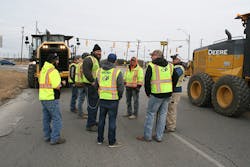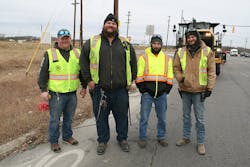Specialists in soil stabilization, modification, full depth reclamation (FDR) and asphalt pulverization, Rock Solid Stabilization and Reclamation, Inc. (Rock Solid) has more than a decade’s experience tackling projects both large and small. Based in the Upper Midwest, the company has performed services in 21 states. Their experience, particularly with FDR, led to a contract with the City of San Antonio, Texas to totally rehab the Woodlake thoroughfare.
According to Topcon Positioning Systems’ Mark Larranaga, senior manager for paving and software business development, “because this road was so badly damaged, the city decided that a standard ‘mill-and-fill,’ would not suffice. Instead, they opted for the full-depth reclamation, an approach in which the pavement and a portion of the underlying materials are pulverized and mixed with a stabilizing agent to strengthen the entire structure prior to the repave.”
He added that the benefits to FDR are many, including the fact that there is no material to haul off site, resulting in a direct cost savings. Also, because the sub-base is being strengthened, the risk of future failure is minimized.
Going Mobile
Long before the FDR process could begin, however, an initial survey of the full 1.3 miles of road was needed to determine the best design. To do that, Jonathan Pease, Rock Solid’s founder and president, worked with the Carol Stream, Ill.-based Topcon Solutions Store to determine an alternative to traditional road surveying techniques. That alternative was the Topcon SmoothRide Paving Solution.
The initial phase of the SmoothRide process scanned the road surface at normal driving speeds and obtained massive amounts of georeferenced points along the route. “We were able to gather more than 180 million points in a two-hour drive of the road,” said Larranaga. “Surveyed conventionally, that would have taken about two days.”
Once the data was gathered and stored, it was imported into MAGNET Collage software to begin construction of the point cloud. Collage processes and handles mass data at speeds as much as eight times faster than comparable software — with quick rendering and visualization capability. From Collage, MAGNET Resurfacing was used to examine the existing road design and begin formulating the pending changes to it.
With a working design in hand, Rock Solid began the FDR process. The company used a road mixer to simultaneously pulverize the existing 3” – 4” asphalt layer and mix it with the underlying base material. Then, in a second pass, the same machine remixed the material, but did so while also injecting a binding agent to stabilize that sub-base.
Got it Under Control
For the grading facet of the project, Rock Solid once again called upon the strengths of GNSS technology to ensure the highest level of accuracy and efficiency. Working off a GR-5 base station, a motor grader, equipped with a Topcon 3D-MC2 machine control system allowed them to come right behind the mixer and get it to final grade in a single pass, according to Gary Johnson, Rock Solid’s operator.
“This particular model is an IGC (integrated grade control) machine, so it comes from the factory with the Topcon machine control solution built in,” he said. “Being able to see the whole project on screen and know what needs to be done, without the need for extensive staking, has been a real plus for us.
Despite hitting a couple of bumps along the way, the project was completed on time and will serve as a showcase for the strengths of GNSS technology in general and the vehicle-mounted Topcon RD-M1 integrated scanner in particular. The road is now in excellent condition and because of the major sub-base work, should remain that way for a long time. In addition, it now has a uniform crown and a constant cross slope throughout, so drainage will be enhanced. In short, the Woodlake thoroughfare will be a much smoother, safer road.
Editor's Note: Scranton Gillette Communications and the SGC Infrastructure Group are not liable for the accuracy, efficacy and validity of the claims made in this piece. The views expressed in this content do not reflect the position of the Roads & Bridges' Editorial Team.

